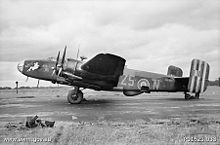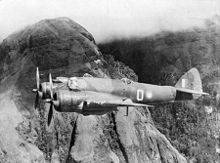History of the Royal Australian Air Force
The Australian Flying Corps (AFC) was formed as a Militia unit, with staff and students to be selected from the Citizen Forces.
In 1911, the Imperial Conference that was held in London determined that the armed forces of the British Empire needed to develop an aviation branch.
The Australian Flying Corps (AFC) was subsequently formed as a Militia unit, with staff and students to be selected from the Citizen Forces, and the first flights by CFS aircraft took place in March 1914.
[2] Soon after the outbreak of World War I in August 1914, the AFC sent aircraft to assist the Australian Naval and Military Expeditionary Force in capturing German colonies in what is now north-west New Guinea.
3 focused on army co-operation roles; smaller squadrons – in reality only flights – of fighters and seaplanes were formed within the RAAF's flying training unit, No.
[6] Throughout the inter-war years the fledgling RAAF focused on local defence and providing training opportunities to Australia's naval and military forces.
Additional squadrons were raised and bases established away from the south-east coast, including airbases in Western Australia, Queensland and the Northern Territory.
[6] This expansion saw the RAAF increase its personnel from under 1,000 in 1935 to around 3,500 in 1939, and the establishment of a force of 12 squadrons, with plans for a further six, by the outbreak of World War II in September 1939.
10 Squadron RAAF, which had been dispatched earlier in the year to take ownership of nine Short Sunderland flying boats and return them to Australia.
A total of 17 RAAF bomber, fighter, reconnaissance and other squadrons served initially in Britain, and/or with the Desert Air Force, in North Africa and the Mediterranean.
[9] With British manufacturing targeted by the Luftwaffe, the Australian government created the Department of Aircraft Production (DAP), which was later known as the Government Aircraft Factories, to supply Commonwealth air forces and the RAAF was eventually provided with large numbers of locally-built versions of British designs like the Beaufort torpedo bomber.
[11] The devastating air raids on Darwin on 19 February 1942 – launched from four aircraft carriers stationed in the Timor Sea – drove the point home.
[12] In the Battle of the Bismarck Sea, imported Bristol Beaufighters proved to be highly effective ground attack and maritime strike aircraft.
The RAAF's heavy bomber force predominantly comprised 287 B-24 Liberators, which could bomb Japanese targets as far away as Borneo and the Philippines from airfields in Australia and New Guinea.
[16][17][18] RAAF Command was charged with defending Australia, except in the north-east, protecting the sea lanes to New Guinea, and conducting operations against Japanese shipping, airfields and other installations in the Dutch East Indies.
[19][20] Its role was thus "mainly defensive" at the outset, with the expectation that "in the event of developments in the North and North-West of Australia, this would be altered".
[14] With over 152,000 personnel operating nearly 6,000 aircraft it was the world's fourth largest air force, after those of the USA, the USSR and the UK.
77 Squadron (77 Sqn), stationed in Japan with the British Commonwealth Occupation Force, were among the first United Nations aircraft to be deployed, in ground support, combat air patrol, and escort missions.
When the UN planes were confronted by MiG-15 jet fighters, 77 Sqn acquired Gloster Meteors, which enabled some success against the Soviet pilots flying for North Korea.
However, the MiGs were superior aircraft and the Meteors were relegated to ground support missions, as the North Koreans gained experience.
[citation needed] Military airlifts were conducted for a number of purposes in the intervening decades, such as the peacekeeping operations in East Timor from 1999.




